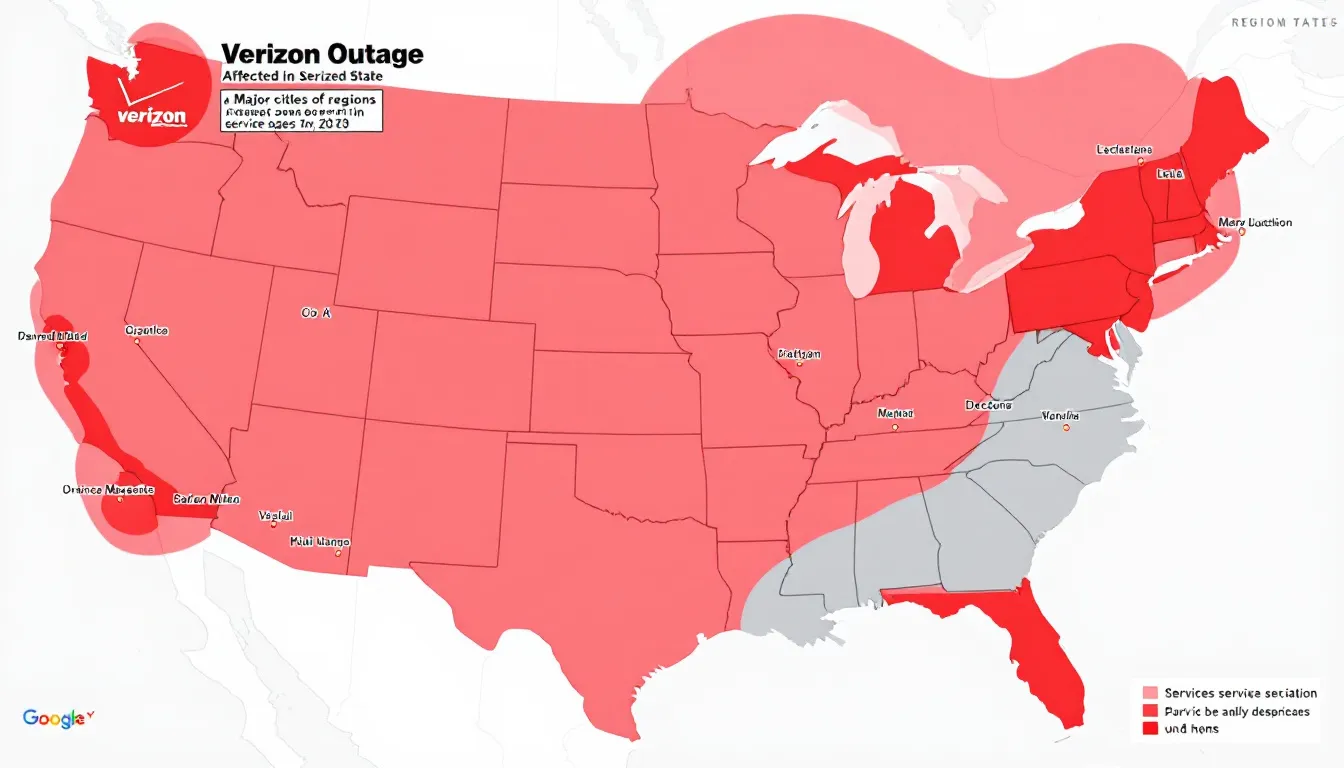Thousands of Verizon customers across the country found themselves without wireless service on Saturday afternoon when a major software issue within the carrier’s network infrastructure caused widespread disruptions. Despite the company’s sprawling network of towers covering as far as Bermuda, the outage left customers unable to make calls, send texts, or access data services for several hours, with many phones stuck in SOS mode that limited functionality to emergency calls only.
The internet was abuzz with speculations whether towers from T Mobile were involved, or whether the culprit was Spectrum’s tower usage overloading Verizon’s infrastructure. Understanding what caused the Verizon outage today helps customers prepare for similar incidents and know what to expect during future service issues.
The disruption affected millions of users nationwide, demonstrating how quickly software problems can impact modern telecommunications networks that people rely on for business, family communication, and emergency services. Groups of friends in affected cities, such as Los Angeles, also found themselves unable to connect, highlighting the personal disruption and social impact caused by the outage.

Introduction to the Outage
On Saturday, August 31, 2025, Verizon customers across the United States experienced a major outage that disrupted wireless service, chat or phone service, and internet connectivity for several hours.
The outage, triggered by a software issue deep within Verizon’s network, left many devices limited to SOS mode, restricting users to emergency calls only. As engineers worked quickly to identify and solve the problem, millions of customers found themselves unable to connect, highlighting just how essential reliable wireless service has become in daily life.
By midnight Eastern Time, both the press and Verizon announced that service was fully restored, but the incident served as a stark reminder of the widespread impact that service outages can have on both individuals and businesses. This date will always be remembered in the log of human error. Fortunately, the chances of this happening are slim to none in the future, but people should always opt to complain if future outages occur.
Primary Cause of Today’s Verizon Outage
The root cause of today’s widespread service disruption of chat and call functionality was a software issue within Verizon’s core network infrastructure. This technical malfunction affected the company’s wireless service across multiple states simultaneously, creating one of the most significant service outages the carrier has experienced this year.
Before everything getting fully restored, Verizon engineers quickly confirmed that the outage was not related to physical network damage, fiber cuts, or external factors such as weather or cyberattacks. Instead, the problem originated from a software glitch that impacted the mobile core network – the central system responsible for routing calls, texts, and data traffic between customer devices and the broader internet.
The company acknowledged the software problem through official statements and deployed emergency fixes to restore service. This type of software issue typically occurs when network updates or patches interact unexpectedly with existing systems, causing cascading failures throughout the network infrastructure.
Unlike localized outages caused by damaged cell towers or regional equipment failures, software issues in the core network can propagate rapidly across vast geographic areas, explaining why customers from coast to coast experienced simultaneous service disruptions.
Outage Timeline and Scale
The scale of today’s Verizon outage became apparent as customer reports flooded in during the afternoon hours. Outage reports peaked at approximately 23,674 customer reports around 3:30 p.m. Eastern Time on Saturday, according to monitoring services that track wireless network disruptions. Customers who reported service issues were often assigned a support ticket, allowing them to track the status of their problem and receive updates on restoration progress.
Service disruptions began affecting Verizon customers nationwide in the early afternoon, with the first reports appearing around 1:00 p.m. ET. The outage reached its peak impact between 2:30 and 4:00 p.m. ET, when the largest number of users found themselves unable to connect to the wireless network.
Full service restoration was completed by midnight, with gradual improvements starting around 9:00 p.m. ET as engineers worked continuously to address the underlying software problem. The total outage duration lasted approximately 8-9 hours for most affected customers, though some users in certain locations experienced shorter disruptions as fixes were rolled out in phases.
The timeline reveals how quickly software issues can escalate in modern telecommunications networks. What likely began as a minor glitch in network software rapidly expanded to affect millions of subscribers across the country within minutes, highlighting the interconnected nature of wireless infrastructure.

Geographic Impact and Affected Verizon Customers
The geographic scope of today’s outage was extensive, with major metropolitan areas including Chicago, Los Angeles, and Atlanta experiencing significant disruptions. Reports indicated that California and Florida were among the states with the highest numbers of customer complaints and service issues.
Rural and urban areas across multiple states were affected simultaneously, which provided clear evidence that this was a core network infrastructure issue rather than a localized problem. Cities from Seattle to Phoenix reported widespread service problems, with customers in business districts and residential areas alike finding their devices unable to connect to Verizon’s wireless network.
The nationwide scope of the disruption distinguished this outage from typical service issues that might affect only a single metropolitan area or region. When software problems occur in the core network, they can impact customers regardless of their physical location, as all traffic routes through centralized systems that manage authentication, routing, and network access.
Some areas experienced more severe impacts than others, likely due to differences in network infrastructure and the specific systems affected by the software malfunction. However, the widespread nature of customer reports across multiple time zones confirmed that this was a systemic issue affecting Verizon’s entire wireless network.
Affected Customer Base
The Verizon outage affected a vast and diverse customer base, with service issues reported from major metropolitan areas like Chicago, Los Angeles, and New York, as well as smaller towns across the country. Social media platforms were flooded with outage reports as frustrated customers shared their experiences and sought updates.
The inconvenience was felt not only by individuals relying on their phones and other devices for personal communication, but also by businesses that depend on wireless service for daily operations. With over 146.1 million subscribers nationwide, Verizon’s network disruption underscored how deeply integrated wireless service is in the lives of customers throughout the country, and how quickly a major outage can ripple through both urban and rural communities.
Impact on Businesses
For businesses, the Verizon outage was more than just an inconvenience—it was a significant disruption to essential services. Many companies rely on Verizon’s wireless service and internet connectivity for processing transactions, communicating with customers, and managing inventory in real time. The software issue that caused the outage left some businesses unable to complete sales, respond to customer inquiries, or coordinate with remote teams, resulting in lost productivity and potential revenue.
Reputational Damage
In some cases, the inability to provide timely service may have led to reputational damage. While competitors like T-Mobile were not directly responsible for the outage, some customers with multiple carriers or shared infrastructure may have experienced related service issues. The incident highlighted how critical reliable wireless service is for business continuity in today’s connected economy.
SOS Mode and Other Customer Experiences During the Outage
For most affected customers, the outage manifested as phones and other devices becoming stuck in SOS mode, which severely limited functionality. In this mode, devices could only access emergency services, preventing users from making regular calls, sending text messages, or using mobile data for internet access.
SOS Mode
Many Verizon customers reported that their phones displayed “SOS” or “Emergency Calls Only” messages instead of the usual network signal bars. This indicated that while the devices could still communicate with emergency services through alternative routing systems, they could not connect to Verizon’s main wireless network for standard services.
Regular calling, texting, and data services were unavailable for affected customers throughout the peak hours of the outage. This created significant inconvenience for people who rely on their mobile devices for work communications, family contact, and daily activities. Business customers were particularly impacted, as many depend on wireless connectivity for operations, customer service, and payment processing.
Phone Service Restoration
Despite the widespread service disruption, emergency services remained accessible through the SOS functionality that operated throughout the outage. This critical safety feature ensured that customers could still reach 911 and other emergency services when needed, even when normal wireless service was unavailable.
Customer service centers experienced extremely high call volumes as users sought information about service restoration and troubleshooting steps. Verizon representatives often expressed that they hear and understand the frustration customers experienced during the outage, emphasizing their commitment to resolving the issue. Many customers turned to wifi connections to contact Verizon through online channels and social media to report issues and seek updates.

Verizon’s Response and Wireless Service Restoration
Verizon’s response to the widespread service disruption was swift, with the company quickly identifying the software issue as the root cause of the service problems. The carrier’s engineering teams mobilized immediately to diagnose the specific nature of the software malfunction and develop appropriate fixes.
Throughout the outage, engineering teams worked continuously to implement fixes and restore network functionality. The company deployed multiple rounds of software patches and system resets to address the underlying problem, with restoration occurring in phases across different geographic regions.
Verizon advised customers to visit the network status page for real-time updates during the outage, providing a centralized location for service information. The company also used social media channels and direct communications to keep customers informed about restoration progress and expected timelines.
The carrier issued formal statements acknowledging the service disruption and apologizing for the inconvenience caused to customers. Company representatives emphasized that engineers were working quickly to resolve the issue and restore full wireless service across all affected areas.
Following full restoration, Verizon continued network monitoring to prevent similar incidents and ensure system stability. The company indicated that additional safeguards and testing procedures would be implemented to reduce the risk of future software-related outages.
How to Check for Future Outages
Staying informed about network status is crucial for managing expectations during service disruptions. Verizon provides several ways for customers to check network status and monitor for potential outages before they significantly impact daily activities.
The primary resource for checking Verizon’s network status is the official status page at verizon.com/CheckStatus. This page provides real-time information about network performance, ongoing maintenance, and any reported service issues across different regions and service types.
Customers can also use the “Check network status” link available through their Verizon online account pages. This personalized view shows status information specific to their service location and account type, helping identify whether issues are widespread or localized to their area.
For proactive monitoring, users can sign up for outage notifications through their Verizon online account. These notifications provide automatic updates about service disruptions, planned maintenance, and restoration progress directly to registered emails or mobile devices.
Third-party outage tracking websites like DownDetector also provide valuable insights by aggregating user reports from across the country. These platforms can sometimes detect emerging outages before official announcements, helping customers understand whether service issues are widespread or specific to their location.
| Method | Description | Best For |
|---|---|---|
| Verizon Status Page | Official real-time network status | Authoritative updates |
| Account Status Check | Personalized service status | Location-specific issues |
| Outage Notifications | Automatic email/text alerts | Proactive monitoring |
| Third-party Sites | User-reported outage data | Early detection |
What to Do During Verizon Service Outages
When Verizon service outages occur, taking the right steps can help minimize disruption and maintain some connectivity options. The most important initial step is to keep devices charged and avoid unnecessary rebooting during confirmed outages, as restarts rarely resolve network-level issues and may drain battery life.
If home internet service is still functioning, customers can use wifi calling capabilities available on most modern smartphones and other devices. This feature allows calls and texts to route through internet instead of cellular networks, providing an alternative communication method during wireless outages.
Even when regular service is unavailable, emergency calls remain possible through SOS mode functionality. Customers should be aware that their devices can still reach 911 and other emergency services even when displaying “No Service” or “SOS Only” messages.
Rather than repeatedly attempting to troubleshoot individual devices, customers should wait for official restoration announcements before spending time on service troubleshooting. Network-level software issues cannot be resolved through device resets or settings changes, making patience the most effective approach during major outages.
For business customers who need immediate connectivity, having backup internet connections or alternative carriers available can provide essential redundancy. Many businesses also maintain landline services specifically for use during wireless network disruptions.

During extended outages, conserving device battery becomes important for maintaining emergency communication capabilities. Customers should consider enabling low-power modes and disabling unnecessary applications that might drain batteries while searching for network connections.
For families with members in different locations, establishing alternative ways to pay, and engage in communication plans through mail, social media, or messaging applications that work over wifi can help maintain contact during network disruptions. Having these backup communication methods identified before outages occur makes implementation much smoother during actual emergencies.
Understanding what caused the Verizon outage today – a software issue in the core network infrastructure – helps customers recognize that such disruptions are typically temporary and resolved through engineering efforts rather than individual device troubleshooting. While frustrating, these incidents demonstrate the complexity of modern wireless networks and the importance of having backup communication options, and other methods of pay available.
The restoration of full service by midnight shows that Verizon’s engineering teams were able to identify and address the underlying software problem effectively. For customers who experienced today’s outage, monitoring the network status page and understanding available alternatives during future incidents can help reduce the impact of similar disruptions.
Preventing Future Outages
To reduce the risk of future service outages, Verizon can invest in strengthening its wireless service infrastructure by adding backup power supplies, redundant network systems, and more advanced monitoring tools.
Proactive maintenance and rapid response protocols are essential for identifying and addressing potential issues before they escalate into major outages. Customers can also prepare by keeping backup devices on hand and ensuring they have alternative connection methods, such as WiFi or service from another carrier, to stay connected during disruptions.
By working together—Verizon enhancing its network reliability and customers planning for contingencies—the impact of outages can be minimized, ensuring that essential services remain available when they are needed most.
Conclusion and Recommendations
The Verizon outage on August 31, 2025, serves as a powerful reminder of the importance of reliable wireless service and internet connectivity in our daily lives. To help prevent similar outages in the future, Verizon should continue to invest in robust infrastructure and implement effective monitoring and maintenance protocols.
Customers can also take proactive steps by preparing backup devices and alternative connection options. If you experience service issues, you can check the network status by visiting the Check Network Status page on the Verizon website, where you’ll find real-time updates and the option to report outages.
For additional support, contact Verizon customer service directly. By staying informed and prepared, both Verizon and its customers can work together to minimize the impact of outages and ensure that essential services remain available whenever they are needed.


